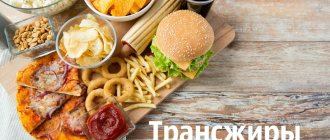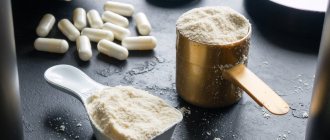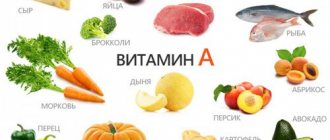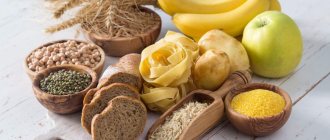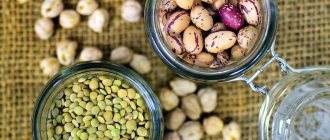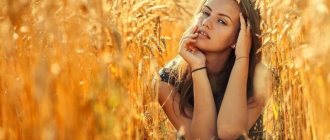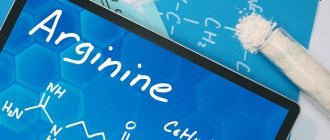A sedentary lifestyle, poor nutrition, bad habits, and poor environment have a detrimental effect on the health of our body.
The most noticeable impact of these negative factors affects the condition of the skin, joints, which over time begin to lose their elasticity, as well as the appearance of hair and nails, which become fragile and brittle.
One of the most important substances responsible for maintaining their beauty and health is collagen. What is this substance? What functions does it perform in our body? What foods contain collagen? You will learn the answers to these questions from this article.
What is collagen
Fresh fruits and vegetables are a source of collagen
Collagen is one of the most important proteins found in the human body. Various vitamins, minerals and organic compounds are involved in its formation.
The main purpose of this protein is to maintain the elasticity of the epidermis and connective tissues.
Collagen is produced by our body. But most of the substances necessary for its synthesis are obtained by eating certain foods.
With age (especially after forty years), the body's production of this substance slows down, and after 70 years it practically stops. This leads to age-related skin changes (wrinkles, sagging skin), joint diseases, and other disorders.
Collagen fibers are quite easily destroyed under the influence of various factors. These include:
Reasons for shortage
Factors influencing the weakening of human collagen production:
- Hormonal imbalance;
- Alcohol, smoking;
- Anxiety, stress;
- Excessive sun exposure;
- The use of diets, consumption of unfortified foods, therapeutic fasting;
- Wrong diet (lack of necessary organic compounds, vitamins)
- Abuse of sweets.
Hormones play a significant role in the production of collagen. Hence its sharp decrease during menopause, which affects appearance. In the first five years after its onset, fibrillar dermal fibers decrease by thirty percent. For the face it is manifested by pronounced withering.
Why does our body need collagen?
Collagen is a vital protein
As mentioned above, collagen is responsible for the elasticity of connective tissue and skin. Thanks to this substance:
- maintains elasticity and firmness of the skin; beauty and health of hair and nails;
- joint mobility and ligament strength are maintained;
- the walls of blood vessels are strengthened.
The lack of this protein affects a person’s appearance and overall well-being. Collagen deficiency may be indicated by:
- deterioration of skin condition, appearance of wrinkles;
- thinning of the walls of blood vessels, their rupture;
- atherosclerosis;
- decreased visual acuity;
- the occurrence or exacerbation of various joint diseases;
- flaking, brittleness, dull appearance of hair and nails;
- decreased muscle strength, decreased bone and joint density;
- feeling tired for no apparent reason;
- the appearance of intestinal problems (for example, frequent constipation).
Thus, collagen is necessary for the normal functioning of various organs and systems of our body. Therefore, it is so important to avoid its deficiency.
Correct selection and maximum absorption
When consuming foods, one must take into account harmful substances that destroy collagen.
A cutlet made from meat is difficult to digest due to poorly digestible ingredients. And it will give only 4-16% of the described energy.
Let's take natural soybeans, legumes - digestibility is about 50%
We neutralize sialic acid in meat (leaches minerals and interferes with absorption into the blood) with salads and fresh vegetables.
Collagen in products is very positive for life. However, you don’t have to focus only on it. Organize your diet to be functional, nutritious, and healthy in every sense. There will be a complex healing effect on the whole body systems, for the face with a fresh, healthy color, and joints.
Daily norm
The required daily amount of collagen depends on various factors: a person’s lifestyle, his age. People who do not experience serious physical activity should receive about five to seven grams of this substance per day.
But the recommended daily dose for athletes or people involved in heavy physical labor increases to ten grams.
To compensate for the lack of collagen, there are various medications and dietary supplements. And the best way to prevent its deficiency is to eat foods that promote the production of this protein in our body.
Targeted nutrition
Amino acids
When drawing up a rational menu, we take into account the presence in products of three AMKs necessary for the formation of protein. Where can I find them?
Proline - 15% of collagen structure. Dairy, seafood, meat, grains, herbs. Daily requirement -5 g. Needed for injuries, rheumatism, dysplasia.
Lysine - cod, yolk, sardine, legumes, lean veal. Creates fibrillar fibers, improves immunity, stimulating the appearance of antibodies. Helps synthesize almost all hormones and enzymes.
Glycine – nuts of all types, basil, peas, beans. Has a beneficial effect on the nervous system. The daily norm is 0.3 g. Activates mental activity, supports depression, heavy physical activity, including joint stress.
Table of foods containing amino acids necessary for collagen production.
Lutein, anthocyanins
We continue to study the helpers, next in line are lutein and anthocyanins.
anthocyanins - cranberries, black rice, blackberries, hot peppers, raspberries, green tea.
lutein - spinach, pumpkin, lentils, peas, corn. carrots, persimmons.
Vitamins, minerals
A – products - eggs, fish liver, pumpkin, lard, butter, apricots, spinach, carrots;
E - beef, pig, chicken liver, legumes, poultry yolk, vegetable oils, Brussels sprouts, almonds, cherries, peanuts, sea buckthorn, broccoli, cherries;
C – tangerines, oranges, lemon, apples, blueberries, currants, persimmons, kiwi;
F - almonds, fish oil, wheat germ, black currants, corn, oatmeal, flaxseed, peanuts, avocado;
D – tanning in the sun, milk, fish;
Iron – buckwheat, shellfish, yeast, chickpeas, quince, cereals, figs;
Silicon - cabbage, bran, porridge, cucumbers, tomatoes;
Copper – special bracelet, cod liver, peas, horns;
Sulfur - beef, gooseberries, in products from ocean inhabitants, beans, grapes;
Zinc – pumpkin seeds, milk.
Table of the minimum norm of vitamins and minerals per day for collagen synthesis and ensuring its good functioning.
Edible gelatin as a valuable source of collagen
Kissel is a source of collagen
Edible gelatin, which is included in various culinary delights, helps to quickly restore collagen reserves in the body. This product is made from connective tissues of cattle: bones, tendons, hooves, etc.
Therefore, it consists of ninety percent collagen fibers, which, when entering our body, are converted into the type of collagen necessary for humans. In addition, gelatin is a low-calorie product.
Thus, dishes prepared with the addition of gelatin are not only very tasty, but also healthy. Therefore, anyone who wants to maintain a normal level of collagen in the body should include various jellies from fruits and berries, aspic, and jellied meat in their diet.
To help vegetarians
Plant products for your own collagen synthesis.
Laminaria – contains iodine and minerals. Versatile help.
Tomatoes are a storehouse of the antioxidant lycopene, protecting exposed skin from strong sun. Relevant for collagen production. It increases when baking tomatoes and drinking juices.
Avocado—with the support of tocopherol (E) keeps collagen unchanged. In addition, it contains elements that are fruitful for dermal cells.
Raspberries, blackberries, strawberries, cranberries are sources of ellagic acid, which protects collagen from direct UV rays. Plus ascorbic acid (C).
Pumpkin seeds inhibit its breakdown and saturate it with zinc.
Chia seeds are a trendy product. Used by those who want to lose weight. Omega-3 supply for vegetarians. Rejuvenation, skin hydration
Greenery - multi-sphere improvement of functions. Chlorophyll preserves protein. The antioxidant properties of which rejuvenate.
Oranges, tangerines, lemons. – ascorbic acid, without which there is no effective absorption.
How does eating eggs affect collagen production?
Bird eggs contain a huge amount of nutrients necessary for humans. It is known that chicken eggs are one of the few products that are almost completely, ninety-seven percent, absorbed by our body.
In addition to a large amount of protein, they contain vitamins of categories A, B, C, D, as well as iron, zinc, sulfur and other trace elements. Many of these substances are involved in the production of collagen, so it is recommended to include them in your diet.
What are the results of taking collagen supplements according to scientific research?
To give you a better understanding of the functioning of collagen and its effect on joints, we will also discuss the research on this in more detail.
The first clinical study we'd like to shed more light on looked at people with osteoarthritis of the knee , which is one of the most common diseases of the knee . Participants were divided into two groups: one received 10 mg of bioactive, undenatured type 2 collagen for ninety days, and the other received a combination of glucosamine (1500 mg) and chondroitin (1200 mg), which is often used for knee pain and osteoarthritis. How did it all turn out? After 90 days of treatment, people receiving type 2 collagen showed a significant reduction in pain during daily activities, which also significantly improved their quality of life. Based on a predetermined index, people taking collagen saw a 20% improvement, while the group taking a combination of glucosamine and chondroitin only had a 6% improvement. [13]
The second study examined the effects of collagen in the treatment of knee osteoarthritis in combination with paracetamol (a pain reliever). In this case, the participants were again divided into two groups. The first received 1500 mg of paracetamol every day. In the second group, the researchers administered the same amount of paracetamol plus 10 mg of the native type 2. The experiment lasted ninety days, after which symptoms and biochemical markers of cartilage degradation were again measured. The group supplemented with collagen experienced a significant reduction in pain when walking compared to the group without collagen. However, differences in biochemical markers between groups were not significant. [14]
Symptoms and causes of excess copper
Clinical picture of Wilson-Konovalov disease:
- Damage to the central nervous system. Extrapyramidal disorders (muscle rigidity, hyperkinesis, tremors of the limbs), sensitivity is not impaired.
- Kayser-Fleischer rings. Characteristic deposits of the element on the cornea in the form of a greenish or brown pigment. Pathognomic symptom.
- Hemorrhagic syndrome. Increased bleeding of the gums and nose.
- Liver damage. Hepatosis, cirrhosis. Manifested by yellowness of the skin and mucous membranes, pain in the right hypochondrium, nausea, vomiting, enlarged veins on the anterior abdominal wall, portal hypertension. There is a high risk of gastrointestinal bleeding and malignancy (degeneration into cancer).
- Profuse sweating, pathological fragility of bones, limited joint mobility, muscle pain, blue discoloration of the nail plates.
- Decrease in the number of red blood cells, hemoglobin, platelets, and leukocytes.
- Change in mental status. Manic-depressive syndrome, schizophrenia, lack of emotions.
- Tendency to inflammatory and infectious diseases.
Excessive intake of copper into the body may be due to work in hazardous enterprises. Patients experience damage to the respiratory tract, mucous membranes, eyes, skin, fever, and pneumosclerosis.
Chronic intake of the element is accompanied by headaches, dizziness, metallic taste in the mouth, and dyspeptic symptoms (nausea, vomiting, diarrhea).
Provoking factors: hereditary deficiency of enzyme systems and the ceruloplasmin carrier protein, taking medications (hormonal therapy, contraceptives, vitamin supplements), consuming foods and water rich in metal.
Okinawa Recipes
The food of the centenarians of the famous healthy lifestyle of the island is plant-based. But the Okinawans' specialty is pork in all forms; absolutely everything is used - legs, tails, snouts. Don't think it's due to lack of money. God forbid we all have such pensions! We are silent about the minimum wage of $3,000!
The most popular dish is a rich soup made from pig's feet. The main fat is removed. What remains is a pure product with collagen and casein. Let's show his recipe:
500 grams of pulp with bones (shank - the part of the ham that is located between the forearm and the drumstick of the animal or loin). Place in a saucepan and add 3 liters of cold water. We wait for it to boil; cook for a long time (at least 2 hours), the heat is as low as possible. Strain and remove the pieces. Pour soy sauce (150 g), rice vinegar (a glass), garlic (three cloves), sugar (25 g), sesame oil (1 tablespoon) into the remaining mass. Continue heating, without boiling. At the same time, cook noodles - 200g. After cooking them, fill it with the resulting bone broth, add the pulp, cut into pieces. Sprinkle with herbs - hello Okinawa!
Tiraga – smoked boar muzzle. Makasi Bazaar brand. Tiraga is placed in the stew.
Stew. It is known that its long cooking does not destroy vit. B1, B6, and collagen increases. Okinawan culinary technology is built on this. Slow heat and long cooking make the cartilage soft and tender, processing excess fat. Traditionally, food is served with vegetables and seaweed, adding flavor and aiding digestion. The remaining product is stored in glass jars; it will be useful in the household.
Rafute - boar's belly. Small pieces are cooked for a long time in a sauce of dashi (ear made from dried mackerel flakes), awamori, soy, sugar, ginger, and garlic. Rafute is the main food during the holidays.
Tebiti – boiled legs.
Let's add some more exotic stuff:
Mimiga – ears are cut into thin slices and marinated. The elders, sitting on a bench, savor them for a long time. Note that the method of preparation came to the Japanese from China.
Juices are a kind of barbecue made from ribs. Okinawa's hit product. The loin is boiled and then simmered.
Soba juice is an Okinawan culinary favorite. The ribs are allowed to boil to remove the fat, then stewed in a solution of sugar, awamori, and soy sauce for about half a day. They bring it to the table with buckwheat noodles in broth.
Elastin and elastokines
There are two types of proteins in the human body: collagen and elastin, which are responsible for the integrity, structure and dynamic movement of all tissues. In this article we will discuss elastin, its formation and role in the body.
Like collagen, elastin is found only in the extracellular matrix; its highest concentration is recorded in the deep dermis - 2%. It is a necessary component of such vital structures of the human body as arteries, lungs, connective tissue of the heart, bladder, tendons, that is, those structures that are constantly stretched and compressed. It is this property that distinguishes elastin from collagen - returning to its original state after stretching. The life of elastin fibers that have avoided degradation can reach up to 75 years.
The formation of elastin occurs in the intercellular matrix in several stages.
This process is called elastogenesis. First, monomeric tropoelastin molecules are formed, then they undergo longitudinal cross-linking by lysyl oxidase (LOX). When bound to fibulin, tropoelastin molecules form a water-insoluble ball. The process of binding dozens of such amorphous coils leads to the formation of fibers of polymer elastin molecules, in which lysine-proline and lysine-alanine cross-links are chaotically created, due to which mature elastin fibers are easily stretched and then are able to quickly return to their previous shape.
Active synthesis of elastin in mammals occurs during the formation of the fetus in the womb; with birth, elastin synthesis begins to gradually slow down and by the age of 50 completely ceases its activity. Local activation of elastin synthesis has been found in cases of damage to connective tissue or skin, as well as in pathologies, for example, in oncology. The most important role in the synthesis of elastin is played by cytokines, which are capable of both activating and suppressing this process. It has been proven that the following factors have a stimulating effect on the formation of elastin: TGFβ1 and IGF-I. At the same time, they are counteracted by bFGF/FGF-2, HBEGF, EGF, PDGF-BB, TGFα, TNF-α and IL-1β factors.
Speaking about the degradation of elastin fibers, this process is carried out under the action of three elastase enzymes:
- The MMP-12 enzyme “pinches off” the tropoelastin molecule in 89 places
- The MMP-7 enzyme “bites off” the tropoelastin molecule in 58 places
- MMP-9 enzyme in 63 places
In this case, in case of damage to the deep dermis, the synthesis of elastase MMP-12 is stimulated, which under normal conditions is produced by macrophages.
Ultraviolet radiation has a huge impact on the condition and changes in the extracellular matrix. UV radiation was found to reduce lysyl oxidase homologue 1 (LOXL1) and activate elafin. As a result, non-functional elastin accumulates, which is aggregates with elafin, while the number of full-fledged fibrils is significantly reduced. In addition, elastase neprilysin, produced by fibroblasts, is activated with age. It destroys elastin fibers, which have previously suffered from elastases MMP-7,9 and 12, which ultimately leads to the decline of elastin structures and a general deterioration in skin indicators: firmness and elasticity.
Elastokins
Elastin peptides that can be triggers of intracellular molecular reactions. The experiment identified the following active elastin peptides: GVYPG, GFGPG, GVLPG, YGARPGVGVGGIP and PGFGAVPGA. The most studied elastokine in humans is VGVAPG, VG-6, which is part of domain 24. This peptide has a stimulating effect on various processes occurring in fibroblasts: melanogenesis, division of procancerous, synovial, dendritic cells and platelets. In astrocytes, the VGVAPG peptide helps reduce nitric oxide and increases the concentration of oxygen free radicals. Fibrous connective tissue contains only fragments of the polymers tropoelastin and elastin, which causes the stiffness of, for example, scars. In cancer cells, VGVAPG activates the elastases MMP-2 and MMP-14, which ultimately promote the spread of cancer cells from the primary site to other tissues.
Information about the ability of elastin fibrils to interact with cells has made it possible to identify elastin receptors. It was found that contact is made through the mediator protein elastonectin. The formation of elastonectin is stimulated by fragments of elastin fibers.
The main receptor for VGVAPG and other elastin peptides is the EBP protein.
It has been revealed that prolonged activation of this protein leads, for example, to thickening of vascular tissue and proliferation of muscle tissue.
The EBP protein lacks enzymatic function, but has two functional regions:
- for binding to elastokines or intact elastin
- to bind sugars
There is an assumption among scientists that all the proteins with which elastokines come into contact have not yet been identified. In some types of cancer, VGVAPG binding to receptors correlates with protein kinase C activity, but this has not yet been empirically demonstrated. There is also no evidence to date of elastin traveling receptors, although elastin fragments have been found in the bloodstream and elastin may affect the endothelium.
In conclusion, it must be added that today elastin is an extremely popular object of study. Elastin-like polypeptides (EPP) have already been isolated, which in their characteristics are not inferior to natural elastin. However, to introduce them into widespread use, they must prove themselves as safe substances that do not cause inflammatory reactions.
Source: https://magazineaestheticmedicine/posts/3061073530794056


